Giving full play to the high-efficiency of high-efficiency tools is a key issue that needs to be solved in the face of many domestic local machine companies. Although the application of advanced and efficient tools is becoming the slogan of more and more enterprises, the management concept and the backwardness of consciousness restrict the further promotion and application of high-efficiency tools. In this issue, the cover article will provide a questionnaire to the tool users to understand the current use of high-efficiency tools in various industries, and invite some experts, tool companies and users to bring together the current status of high-efficiency tool applications.
In fact, the significance of this kind of investigation is not the persuasiveness of the data, but the extraction of reasonable opinions and the foresight of the micro-sense through the vividness and comprehensive participation of the case.
In this survey of the current status of efficient tool use, the tool user companies involved in the aerospace, mold, automotive and parts, steam turbine, ship, gear processing and general machining industries, the head of the hundreds of competent tools or The tool engineer sent a questionnaire fax or e-mail, and received 93 questionnaire responses. The industries and enterprises involved have a certain degree of generality and representativeness.
Efficient tools in the user's eyes High speed, high metal removal rate and high cost performance are the most used words by respondents, and 90% of the questionnaires contain such descriptions of efficient tools. Other expressions such as tool life, high feed rate, stable processing quality, and short processing time also account for a large proportion.
Comment: In fact, regardless of high speed, high metal removal rate, tool life and high feed, it is combined that this tool can greatly improve the processing efficiency compared with the traditional tool. This is the interviewee of all the participants in the survey. consensus.
Efficient tool usage is divided by industry. The aerospace and automotive and parts manufacturing industries use the highest proportion, which is between 60% and 90%. In other industries, the ratio is between 5% and 45%, of which general machinery The processing industry uses the lowest proportion. From the type and scale of enterprises, the proportion of efficient tools used by large enterprises, Sino-foreign joint ventures and foreign-funded enterprises is much higher than that of small-scale and domestic-funded enterprises. The proportion of use is mostly over 35%, and the proportion of domestic small-scale enterprises is relatively low. Between % and 20%.
Comments: From the survey results, the application of high-efficiency tools in different industries and enterprises of different scales is very different.
How to select and use efficient tools What factors of efficient tools affect the user's choice? The improvement rate of processing efficiency is 80% of the respondents' choice of efficient tools. 45% of the respondents will consider the procurement cost of the tool and the after-sales service of the tool manufacturer. Only about 20% of the respondents will get the tool brand. Select the tool from the angle of influence.
Twenty-two percent of respondents recognized the company's use of efficient tools in all processes and the use of highly efficient tools in some key areas, while 56% of respondents believe that efficient tools should be used in the right process.
Obstacles and measures What are the factors that hinder the promotion of efficient tools? Among the many options such as funds, tool application technology accumulation, process, processing concept, small batch processing and no understanding, 70% of the respondents believe that the processing concept is the biggest obstacle to the promotion and application of high-efficiency tools. 40% of the respondents chose funds, 30% of the respondents chose process and tool application technology accumulation, and only a few chose low-volume processing. Other respondents also gave other opinions, such as equipment conditions, and domestic tool materials.
Correspondingly, more than 80% of respondents believe that it is imperative to popularize high-efficiency processing concepts. Other respondents who believe that measures to improve technology, increase technology accumulation and increase capital investment account for 45% of the total number of respondents, respectively. % and 30%. A small number of respondents also believe that the pace of machine tool upgrades should be accelerated and research on tool performance should be strengthened.
The tool brand that deserves recognition finally lists nearly 20 kinds of tool brands including imported and domestically produced in the domestic tool market (not listed here). More than 90% of the respondents are more recognized in the international arena. The reputation of the international brand of tools, and the domestic tool brand in the field of efficient tools still need to work hard. Among the reasons given by the respondents, the quality is stable, the price is reasonable, the service is good, and the use or use is mostly.
Comments: It can be seen that domestic high-efficiency tools still need to continue to strengthen research, quality and service to occupy a place in the fierce competition.
The application of high-efficiency tools requires a long-term tool to be placed in a large environment that includes equipment, management and process conditions. From high-speed cutting advancement to efficient cutting and then advanced to efficient machining, there are many articles that can be done. The scope has been improved step by step. In the tool selection, the user can only get more benefits if he is in an equal position with the tool manufacturer.
Gao Xiang, honorary director of the China Knife Association:
High-speed cutting, high-efficiency cutting and efficient machining have always been the focus of the Chinese Knife Association in recent years. The earliest advocacy of high-speed cutting originated from some phenomena at the end of the last century. At that time, many companies spent a lot of money to purchase foreign good processing centers, but they were reluctant to purchase good tools, resulting in insufficient use of machine tools and inefficient production. Of course, due to various restrictions in policies and systems, the shortage of contract orders by enterprises is also a cause of this phenomenon.
In fact, having good equipment but not having the right tools for supporting production is a greater waste of resources. The operating rate of the machine tool is insufficient to reduce the production efficiency, and the depreciation of equipment and fixed assets causes the production cost to rise. It is in this situation that we advocate high-speed cutting to improve processing efficiency and reduce processing costs. This is also the theme and center of the “First China Tool Association Advanced Tool Cutting Technology High-Level Forum†held in Nanjing in 2003. The value of the tool in machining itself is not high, but the role played is very important, because the tool is the most dynamic factor in the cutting process. There is good equipment and no matching tool is actually missing a leg, efficiency Still can't go up.
The use of high-speed cutting is to improve the processing efficiency and reduce the cost, but it cannot be high speed and high speed. The other two things cannot be ignored. First, other methods can also improve the efficiency and reduce the cost. Second, the real cutting time only accounts for the processing. 1/3 to 1/2 of the time, the improvement of management level, the reduction of auxiliary time and the application of advanced technology can also improve the processing efficiency. So we began to advocate high-speed cutting without ignoring efficient cutting. Advocating efficient cutting, in fact, through the use of high-quality tools and process reforms to improve processing efficiency, this time is no longer all rely on CNC equipment to improve efficiency, but also depends on tool structure improvement and process improvement.
Tool users have come to the fore in one road, and many industries in China do not currently have equipment that uses imported high-quality tools. Therefore, it is recommended to use high-efficiency cutting and other methods to improve efficiency. Large cutter milling cutters and turning tools are not simple to increase the amount of cutting. It is necessary to make some improvements in the tool structure and design, such as increasing the rigidity of the tool, optimizing the force parts, etc. The example is the development of crankshaft machining from milling cutters, broaches to high-speed milling cutters. The cutting efficiency has been improved by more than 10 times. There are also composite tools that can complete a variety of processes. If you compare high-speed cutting to fighting, then more efficient cutting is more wits.
The tool needs to be placed in a large environment that contains many factors such as equipment, management and process conditions. From high-speed cutting to high-efficiency cutting, there are many articles to be done in the process of advancing to efficient machining. The concept and scope of this tool has been step by step. Step up. High-speed cutting, high-efficiency cutting and high-efficiency machining are mutually exclusive. High-speed cutting has its own advantages. While developing high-efficiency cutting, it does not oppose the use of various methods to optimize the machining process, improve machining efficiency, and depreciate. It is processed efficiently. The problem is that the current foreign tool manufacturers have strong technical research and development and production capacity, they will have a total solution to the user, which is very convenient for users. But we have to see that in the tool selection, only the tool manufacturer is in an equal position to get good returns. Therefore, our tool users can't rely too much on the tool manufacturer's solution. They need to actively seek the tool solution. They need to know how to use the tool and can improve the shortage of the tool. Therefore, much research and promotion in the basic theory and practical application of tools and applications requires a lot of work.
Changing the traditional processing consciousness is imminent. The use of efficient tools also needs to strengthen technical training and publicity, and the level of awareness of business managers needs to be improved. The misunderstandings brought about by traditional processing concepts need to be changed, and it is important to choose reasonable cutting parameters.
Shi Guozhong, President of Tianjin Metal Cutting Application Technology Association:
The so-called high efficiency is literally high in efficiency, and can be significantly and multiplied in comparison with conventional conventional tools in terms of processing efficiency and service life. This is a different concept from high-speed cutting. The analysis can be carried out with two types of tool examples: drill bit and cutting knife.
U-drill is the first high-efficiency shallow hole drill developed by Sandvik Coromant, which can achieve a maximum length to diameter ratio of 4 times. The appearance of the U-drill changed the efficiency of the hole machining. The cutter head part is a cemented carbide insert. It uses internal cooling and a hard alloy spiral arbor. Its processing efficiency is 3 to 5 times higher than that of ordinary high-speed steel twist drill. . What is the difference between the two tools? The high-speed steel used in ordinary twist drills has poor heat resistance and poor red hardness, and although it has good toughness, it is not wear-resistant. The tool of cemented carbide has great advantages in wear resistance, but the cost of twist drill of hard alloy material is too high, which is not suitable for large-scale promotion. Therefore, it can be considered that a tool similar to U-drill is a typical hole machining efficient tool.
Cutting knives currently used on CNC machine tools are generally highly efficient tools. Conventional machine tools have low spindle speeds and can only use high-speed steel cutters. The cutting efficiency is not high enough when cutting steel workpieces, not to mention various alloy workpieces, and in addition to the long cutting time due to low speed. It will be easy to use a knife, causing damage to the machine. The indexable carbide insert tool with the machine clamp makes the blade easy to change, which can achieve a large amount of cutting and higher cutting efficiency.
The use of efficient tools also requires technical training and publicity efforts, and the level of awareness of business managers needs to be improved. Traditional machining companies use low-speed common tools to summarize the appropriate cutting parameters and make it a habit, while at the same time avoiding high-speed cutting, which is believed to cause damage to the tool. However, after replacing the high-efficiency equipment of CNC machine tools, the use of high-efficiency tools will lead to machining misunderstandings. In fact, unreasonable high speed will cause tool wear, but it is important to choose reasonable cutting parameters. Many companies are still using low-speed machining after purchasing high-efficiency tungsten steel or carbide tools, but tools are more susceptible to damage. This problem is common.
There are many things that need to be done to change this situation. Like the Tianjin Metal Cutting Application Technology Association, I will organize an event every once in a while to promote the popularization and improvement of high-efficiency tool application knowledge for the workers who are learning at the technical level. It is also possible to publish some popularizations in related publications. Sex articles will allow more workers who see the magazine, including technicians and business managers, to improve their technical level and processing awareness, and further increase the popularity of CNC equipment.
Full and reasonable performance of efficient tools High-efficiency tools should have high feed, high speed and high cutting efficiency to achieve the ultimate goal of high efficiency. In the face of increasingly fierce market competition, improving production efficiency and reducing costs have become the key to the survival and development of enterprises. At this stage, the automobile manufacturing industry and its manufacturing equipment suppliers are constantly improving and adapting to competition in various aspects, among which the application of efficient tools is the most One of the important means.
Shanghai General Motors Co., Ltd. Li Jianbang:
The requirement for improving efficiency in the powertrain production of the automotive industry is to use as few machine tools as possible to produce as many parts as possible in a unit time. For efficient tool applications, it is to increase the metal cutting rate per unit time and reduce the machine tool. Non-cutting auxiliary time increases the starting rate of the machine. Improve the metal cutting rate per unit time of the machine tool, mainly through the high cutting speed and high feed of the high-efficiency tool; reduce the non-cutting aid of the machine tool through the reasonable and large-scale use of the combined tool with high efficiency, high quality and high stability. Time, to achieve the purpose of improving the production efficiency of the powertrain production line, which not only reduces the processing time, but also reduces the auxiliary time such as tool change, improves the production cycle and improves the production efficiency; improves the tool life and reduces the tool by optimizing the application. The frequency of tool change in production increases the starting rate of the machine tool, thereby increasing the production efficiency of the production line.
Efficient tools not only directly reduce the tooling cost of the powertrain, but also indirectly lead to a significant reduction in production costs, in line with the "lean production" principle - to maximize economic benefits with minimal investment. The leading role of high-efficiency tools in reducing the cost of powertrains is mainly reflected in reducing equipment investment, reducing the cost of parts and tools, and reducing production costs.
The price of high-efficiency tools is often relatively expensive, but sometimes cheaper tools can achieve good results, so only the right ones are the best. However, the performance of high-efficiency tools is generally much higher than that of conventional tools, and the cost of single-piece tooling for integrated parts is generally significantly reduced. For example, the same size specifications of carbide reamer and PCD reamer on the engine aluminum alloy parts, the price of the PCD reamer is generally 3 to 5 times that of the cemented metal reamer, the tool life of the PCD reamer is generally 10 times the carbide reamer, the cost of a single piece of tool can generally be reduced by 50% or more. For existing production lines, the continuous development of tool technology enables tool costs to continue to decline while the tool performance is fully utilized. New materials and new coatings for high-efficiency tools, the tool life is often 10% to 30% higher than the original tool, and the price is generally comparable.
The efficiency of high-efficiency tools on the production line is ultimately reflected in the reduction of production costs, such as reducing the unit processing time of parts, reducing tool change time, increasing machine start-up rate, reducing tool management costs, and reducing tool inventory costs. High-efficiency tools will not produce good results if they are not used properly. According to reports, some companies purchase a large number of imported high-performance machine tools, but they use traditional low-performance tools. The performance of the machine tools only plays 10% to 20%. Due to the short tool life, the machine tools frequently stop and change tools. On the surface, the cost of the tool may be relatively low, but in terms of the production cost of the part, the cost of the part is bound to increase significantly as the depreciation cost of the device is spread over fewer parts. So the wise choice should be to apply efficient tools to maximize the machine's unit time output, thus reducing production costs as much as possible.
Training plays an important role in promoting efficient tool applications For most companies, there is a problem with large-scale promotion of high-efficiency tools, namely the lack of operators who use efficient tools. Therefore, the purchase of advanced tools is not the key to solving the problem, the key is to train with efficient tools.
Zhao Jianyong, deputy chief engineer of Hangzhou Steam Turbine Co., Ltd.:
We believe that one aspect of defining efficient tools is to look at metal removal rates, especially in conventional processing. Although some cutting tools are almost the same as standard tools, there are many machining methods. One knife can solve different machining requirements, saving tool change and clamping time. This can also be called high efficiency tool. Moreover, high-efficiency tools are not just high-speed tools. The high-speed operation of tools is only one of them. It is another basis for judging high-efficiency tools because it can improve efficiency compared with traditional machining methods. For tools that require high-speed cutting, there are high demands on the spindle, rigidity and power of the machine. However, for most factories, the machine tool is ready-made, so there are many choices for the tool, such as the large pass and the large feed, that is, the tool is in the same speed as the existing machine. The structure is improved. Under the premise of not affecting the chip removal, the cutter head is arranged with dense teeth to increase the amount of cutting.
Hangqi has been promoting the advanced and efficient tools for some years, and has achieved good results in terms of improving efficiency, but also encountered some problems in the process of promotion.
For most companies, there is a problem with the large-scale promotion of efficient tools, namely the lack of operators who use efficient tools. After the application of high-efficiency tools, unless the process department gives the various parameters after the trial processing to the workers, the processing will be ideal, but the product is changed, and the original parameters can not be used to achieve good processing results. Therefore, the purchase of advanced tools is not the key to solving the problem, the key is to train with efficient tools.
However, it is unrealistic for most workers to leave the company to participate in the training. Most of the participants are part of the backbone workers, so there are some other ways to meet the needs of the workers in the training of workers. Each manufacturer's tool products, especially high-efficiency tools, have their own characteristics. The tool supplier can provide some training documents on how to use the tool to the user. The user can establish his own training materials and training system according to his own characteristics and actual production conditions, so that the workers can participate in the training at any time. Moreover, the advanced information in the current training system cannot be updated in time, and there is no good training material. This requires changes. We consider integrating the service quality of the tool supplier and the provision of training materials as an assessment, and become one of the basis for selecting suppliers.
Hangzhou Auto is preparing to hold a symposium of tool suppliers at the appropriate time this year. One is to express training needs to various companies, and the other is to present the existing low-efficiency processing cases of the collected factories and let the tool suppliers propose solutions. Make an adjustment to the supplier based on the degree of response and the satisfaction of the training service.
Equipment development for efficient tool creation application platform With the development of China's manufacturing industry and the application of CNC machine tools, the overall level of domestic equipment has been greatly improved, and foreign advanced processing concepts have been continuously introduced into the country. In fact, it has created a good platform for the application of high efficiency tools.
Shanghai Taopa Trade Co., Ltd. Design Director Tax Tao:
The so-called efficient tool, we think it should be understood from the following two aspects:
One is to use a higher cutting amount. Through the application of high-performance cutting materials and the optimization of the design of the tool structure, the tool can be applied to higher cutting speeds and feeds;
The second is to reduce the auxiliary time. By analyzing the actual machining process, we find that the auxiliary time of the machine tool also occupies an important ratio compared to the cutting time. Therefore, another direction to improve efficiency is to properly combine some processes on a tool and reduce the non-cutting time by reducing the tool change time as much as possible.
As the most well-known company in the industry for non-standard tool solutions, Marpa has always improved processing efficiency as the primary goal of serving customers and has a range of high-performance products to meet the different needs of customers:
As a finishing tool for Marpai, the bar-type tool guarantees excellent dimensional accuracy, shape tolerance and surface roughness of the machined hole. With "First part, good part" we can greatly reduce the customer's processing. Auxiliary time; a new development tool TSW and TFB combined with vertical blade and guide bar tool design, TSW rough boring tool is a roughing tool using convex triangular vertical blade, because the tool is in processing The blade can be supported by itself in the machined hole, plus the positive rake cutting design allows for large depths of cut while using large feed rates without vibration. TFB is a finishing boring tool for IT7 to IT8 precision holes. Because it is a multi-tooth design, it can increase efficiency by 6-8 times compared with ordinary single-edged boring tools.
For aluminum alloy parts processing, Marpa has a very complete diamond product line. For flat machining, Marpa offers face milling cutters with cutting speeds of up to 9000 m/min and HP series end mills with metal removal rates up to 6.5 L/min. In terms of hole processing, Marpa also has many years of experience, can design non-standard hole machining tools according to customer requirements; standard HPR reamer series with diameter ranging from D3.98mm to D65mm using Marpa HFS interface, especially suitable For high-speed machining, the knife has a design for through holes, blind holes and different workpiece materials, while the HFS interface ensures fast replacement of the reamer head with repeatability of 0.003mm.
In the field of solid carbide tools, in addition to providing a complete range of drills in accordance with DIN standards, Marpa can also provide a four-blade, GIGA drill with at least a doubling of feed rate and direct drilling to achieve IT7 accuracy. Drill reamer products; for solid carbide drills, as the price of cemented carbide materials continues to rise, the pressure on material costs is increasing, so Marpa developed the TTD drill bit, which is a steel arbor The drill bit of the combined carbide tip is connected to the ratchet disk interface of the TTS to ensure good torque transmission and self-centering performance. Compared with solid carbide drills, the performance is the same but the cost is greatly reduced; the unfolding tools that use the drawbar drive to achieve the compound motion of the tool used to be used on special machine tools. Now, for the wide application of machining centers, Marpa has already adopted this concept. Transplanted in the machining center, the function of the rod drive is realized by mechanical, coolant and centrifugal force.
However, in the communication with customers, we also noticed that many customers only pay attention to the purchase price of the tool in the application and selection of the tool, and neglect the comprehensive cost in the whole process. In fact, the cost in the process includes not only the cost of the tool, but also the cost of the machine tool and other auxiliary work such as inspection and tool adjustment. Through the application of efficient tools, we can reduce the overall cost by improving machine utilization, improving process stability, tool life and reducing other adjustment time.
Popularizing high-efficiency tools requires multi-pronged high-efficiency tools. Compared with traditional tools, it can greatly improve production efficiency. It is the consensus of all respondents, and the deep-rooted traditional processing concept is one of the biggest factors hindering the rapid expansion of high-efficiency tools. Long-term training measures and systems are one of the effective ways to popularize processing concepts and increase skilled personnel. The most important thing is the expectation of domestically produced high-efficiency tools, and hope that they will eventually compete with imported tools.
Modern high-efficiency tools are developed along with the needs of modern manufacturing. The development of modern CNC equipment has made it impossible for traditional standard tools to adapt to new processing requirements. Efficient tools quickly replace traditional standard tools and become the matching tool for advanced and efficient CNC equipment. The most important application of efficient tools is high efficiency. Whether it is high speed, high metal removal rate and high price, or tool life, suitable for high feed, stable processing quality, short processing time, etc., it is combined that high efficiency tools can greatly improve processing efficiency compared with traditional tools. This is one of the feelings of the reporter during the investigation.
The definition of an efficient tool should not be a narrow definition. The reporters have deep feelings during the investigation and interviews. Many people think that regardless of the material of the tool, the processing efficiency can be improved by other techniques such as improving the process. Even so, the promotion and use of high-efficiency tools is inseparable from the investment in research experiments and the accumulation of substantial technology. At present, most of China's machinery processing enterprises, especially small-scale enterprises, do not have the conditions for efficient tool use, or even if they have the conditions, because the managers do not have enough knowledge, they are reluctant to invest in the use of efficient tools.
Popularizing the processing concept is the most important thing in promoting efficient tools. From the survey results, it is found that the application of high-efficiency tools in different industries and enterprises of different scales is very different. From the industry point of view, the aerospace and automotive and parts manufacturing industries have the highest proportion of use, and the general machining industry has the lowest proportion. From the type and scale of enterprises, the proportion of efficient tools used by large enterprises, Sino-foreign joint ventures and foreign-funded enterprises is much higher than that of small and domestic enterprises.
Insufficient capital investment, insufficient tool application technology accumulation, backward process and processing concept are the biggest obstacles to the promotion and application of high-efficiency tools, especially the backward traditional processing concept (using cheap tools to control costs) is even more powerful. Difficulty. China's manufacturing industry is "big but not strong", and many companies' manufacturing technology is not high, which seriously restricts the further development of China's manufacturing industry. Many enterprise managers still have insufficient understanding of using modern cutting technology and high-efficiency advanced cutting tools to improve production efficiency and reduce costs. The development of modern cutting technology and efficient cutting tools is still unbalanced. Many companies still only pay attention to relying on cheap labor to reduce costs. Rather than paying attention to improving production efficiency by improving processing technology. Advanced CNC machine tools are not equipped with high-efficiency tools, and still use traditional standard tools. The cutting technology is backward, so that the processing efficiency of high-efficiency machine tools is not exerted, which seriously affects the improvement of production efficiency and restricts the modernization of manufacturing. Many companies have spent a lot of money to buy CNC high-efficiency machine tools, but they are reluctant to spend a lot of money to buy advanced and efficient tools, resulting in backward cutting technology and low processing efficiency. In fact, it saves a small amount of money, but it wastes expensive machine tool hours. .
Shi Guozhong, president of the Tianjin Metal Cutting Application Technology Association, said: "The effect of using modern cutting technology to improve machining efficiency is extremely obvious. The traditional machining companies use low-speed ordinary tools to summarize the appropriate cutting parameters, but in the replacement of CNC After the efficient machine tool, the use of high-efficiency tools with traditional cutting parameters will create machining misunderstandings. In fact, unreasonable high speed will cause tool wear, but choosing reasonable cutting parameters will avoid risks. Many companies are buying After entering high-efficiency tungsten steel or carbide tools, low-speed machining is still used, but the tool is more susceptible to damage. This problem is very common." He gave us a real example. One company uses CNC gantry milling to machine a cross-shaped keyway with a width of 10 mm and a length of 4.7 m × 2.2 m. The carbide tool used will soon be damaged. Shi Guozhong found the problem after understanding the number of tool revolutions, the amount of cutters and the depth of the knife. The cutting parameters used on the machine tool are also the traditional tool machining parameters. Now, after changing the tool, the parameters also change. He suggested to increase the amount of the tool by 6 times and the number of revolutions by 4 times. When the machining is repeated, the machining time is shortened, the machining accuracy is improved, and the service life of the tool is longer than that of the ordinary tool. This problem of not using efficient knives is common in many companies.
Establishing Reasonable and Effective Training Measures and Systems The lack of skilled workers who understand and be proficient in the use of efficient tools is a problem in the current promotion of high-efficiency tools for many companies. Therefore, the purchase of advanced tools is not the key to solving the problem, the key is to train with efficient tools. In the survey, many people told reporters that the current domestic training system and skilled personnel education can not meet the growing demand.
The traditional master's apprenticeship method has been unable to adapt to the growing tool cutting technology, and the equipment in the technical school is outdated, and the dissemination of advanced processing information is also lagging. The advanced foreign skill training concept should be introduced. Zhao Jianyong talked about the technical school training model he saw in Germany. A German technical school that cooperates with enterprises to train students. After receiving one year of basic cultural education, the student union accepts the processing tasks given by the teacher at the first-line processing site, and the students independently carry out the process. Orchestration, CNC programming and tool selection, and discuss the best machining plan with the teacher. In this way, when the student graduates into the factory, he can independently complete the processing of various types of workpieces and master a variety of numerical control equipment. On the other hand, our technical school training model, students' knowledge of learning in school has lagged behind, and independent hands-on ability is not good. It takes a period of study to enter the factory to work independently. The gap between the two is very obvious.
In addition to the large amount of highly efficient tooling personnel available in school education, the factory itself needs to train existing workers. The idea is proposed by the company, and it is also a good suggestion for the tool supplier to provide tools for using the tool with different characteristics. It is also a good suggestion for the user to cooperate with the actual production. It is worthy of discussion by tool users and tool suppliers. .
The use of training to popularize efficient processing concepts is not only for technical personnel, but also for the management of the company. After all, the management determines the purchase of efficient tools. At the same time, business operators must have a long-term perspective and cannot only focus on immediate interests. In the process of machining, the cost of the tool is only a small part, and the use of high-efficiency tools will increase the cost of the tool. However, because of the increase in efficiency, the cost of a single product will decrease.
“In addition to various technical trainings, the media in the metal cutting technology industry should also take responsibility for daily reporting and publicity, publish more articles on efficient tool promotion and application, or use a large readership to organize forums or Other forms of activities to further promote the popularization of efficient processing concepts." Shi Guozhong said.
The development of domestic high-efficiency tools has a long way to go. The results of this survey are also shocking to reporters. The impact of domestic high-efficiency tools is small, which makes people feel sad. Strong multinational tool companies have entered China with great technical and economic strength, or set up wholly-owned companies in China, or set up processing factories, which have seized a large share of China's huge efficient tool market.
Under this circumstance, the domestic tool enterprises are required to survive and develop. Only by turning a blind eye to the new environment brought about by economic globalization, fostering strengths and avoiding weaknesses, deliberately making progress, and plunging into the international market with fierce competition and full of opportunities and challenges. In the hardships, exercise skills and create a living space. In fact, in the powerful situation with price and home advantage, domestic tools are far less in terms of quality stability, pre-sales service and technical support than foreign tool companies, especially in terms of overall tool solutions. There are still many shortcomings in the enterprise.
Many respondents said in the questionnaire that they are very supportive of using domestically produced knives because they are cheap, and the second is close to the delivery period. However, they are still very cautious in using domestic knives and must go through relevant It will be used after effective long-term verification. This puts a warning to our domestic tool companies, and the price competition is never as good as the competition in technology research and development. Therefore, it may be a good choice to invest in manpower and financial resources to select a point of entry in an efficient tool. Many foreign tool companies start to grow bigger and stronger from a certain tool field. Our tool companies may wish to do so. Also learn to strive to gradually improve the competitiveness of the entire domestic efficient tool market and rebuild user confidence.
Sealand is a trustworthy manufacturer of CNG Dispenser Mass Flow Meter, LNG Dispenser Mass Flow Meter, LPG Dispenser Mass Flow Meter, ATEX, CE & IECEx approved.
With its high accuracy, wide rangeability and reliable performance, Sealand meter has been applied in many kinds of industries during the last 8 years. Unlike others who only focus on the measurement of liquid at normal pressure & temperature, Sealand has conquered the difficulty in the measurement under severe conditions, such as high pressure, high viscosity, high & low temperature.
Take CNG (compressed natural gas) for example. As the saying goes, the meter can measure anything else if it can measure CNG. It is quite hard to measure gas under high pressure. The sensor must be able to bear high pressure; in this way, the thickness of flow tube must be increased, so the transmitter shall be more sensitive to detect the signal; however, Sealand made it. Sealand's first model is specially designed for CNG dispenser, and now thousands of this model are put into use on the market.
Here are the pictures of Sealand Mass Flow Meter in Dispenser for your reference.
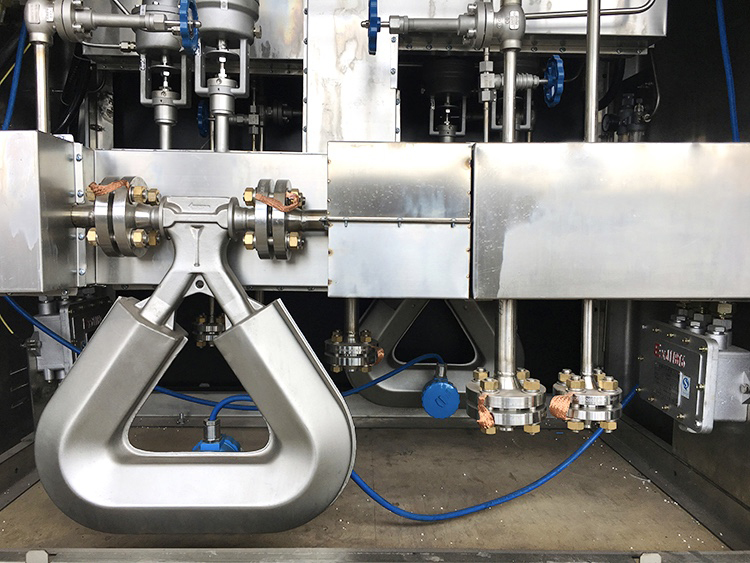
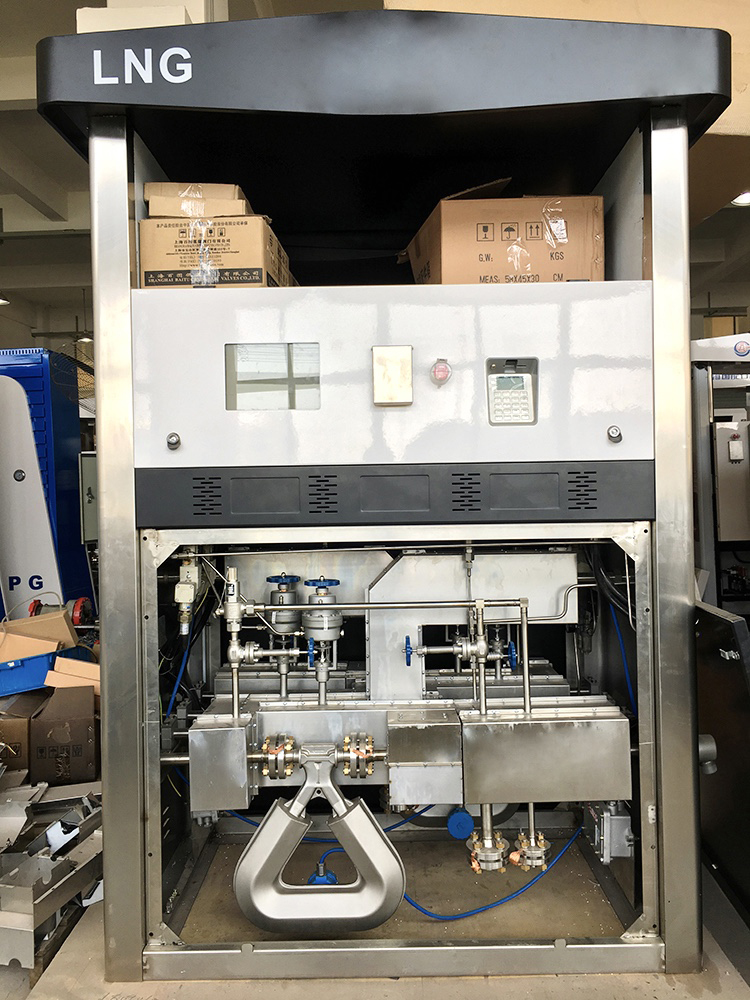

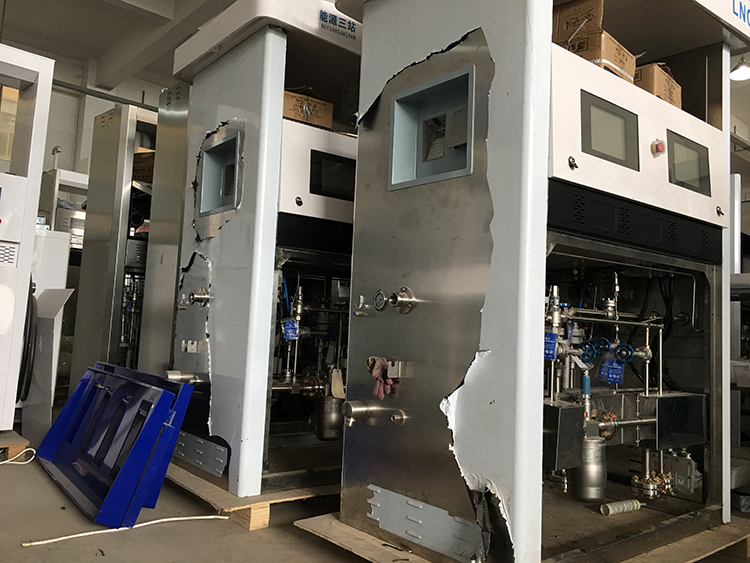
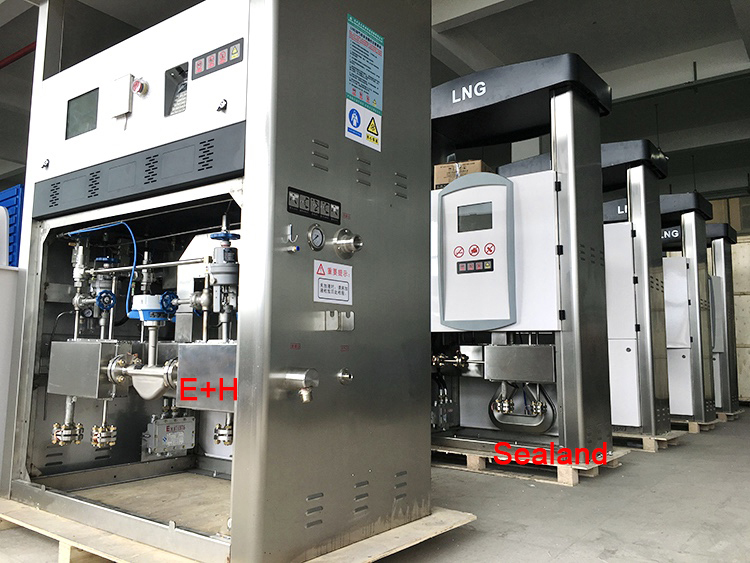
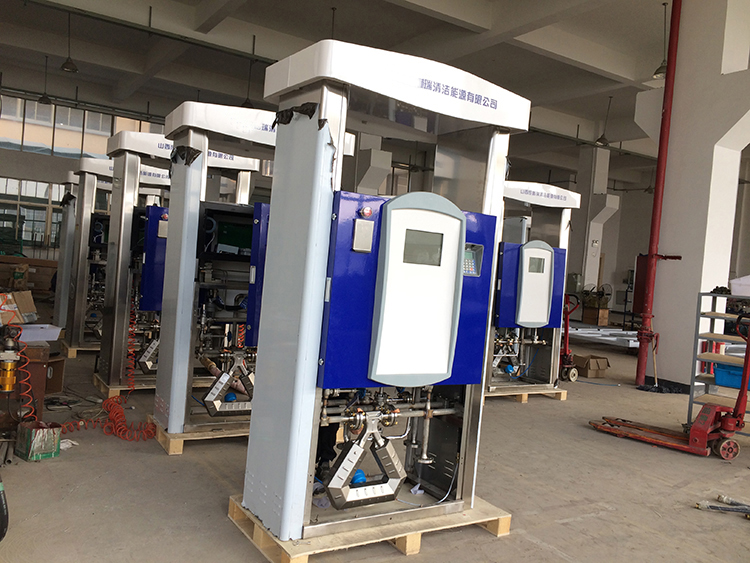
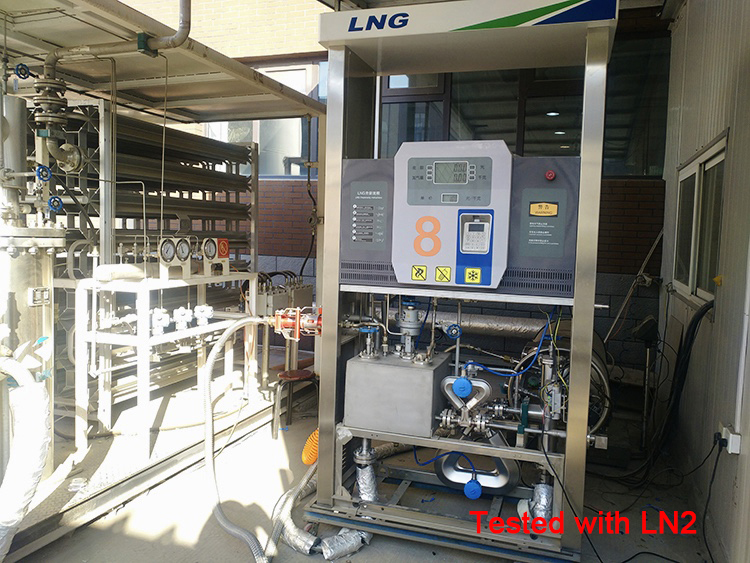

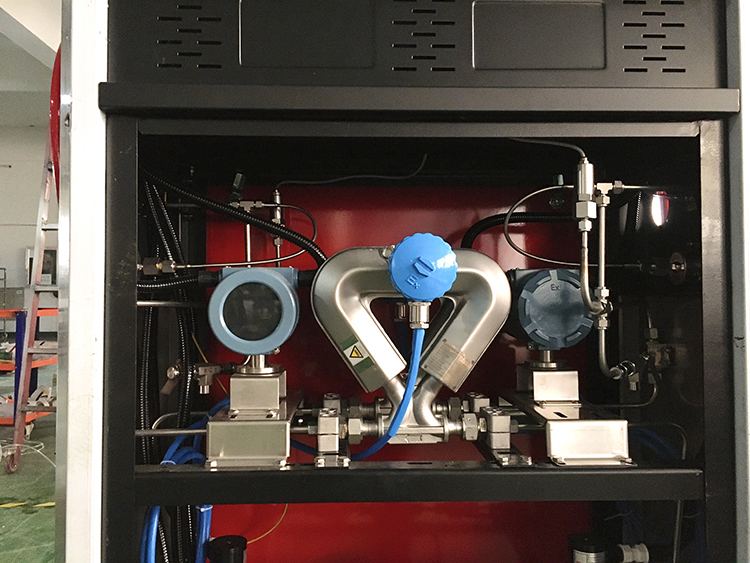
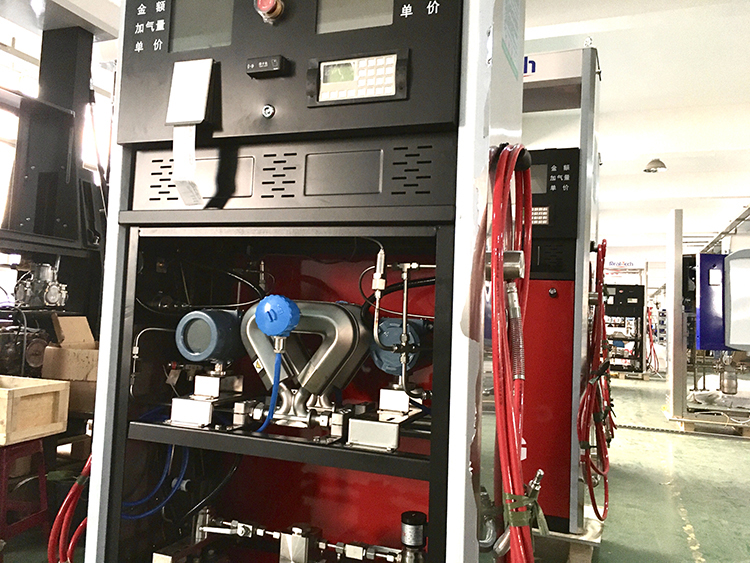
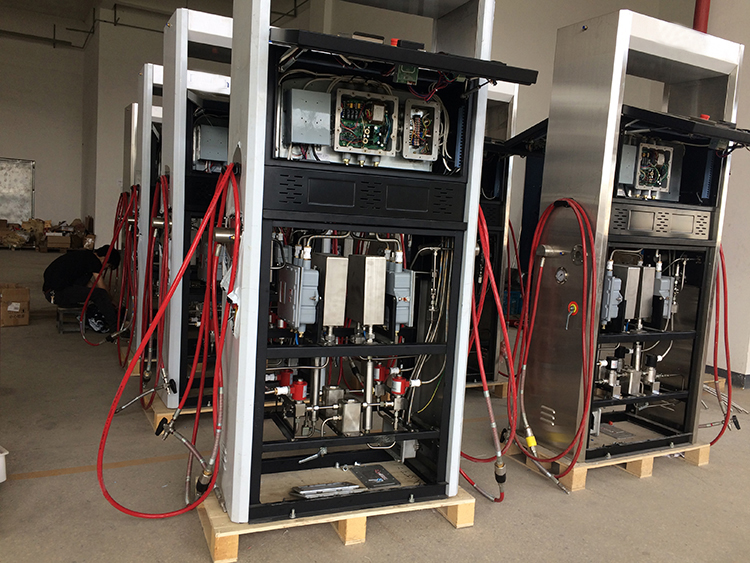
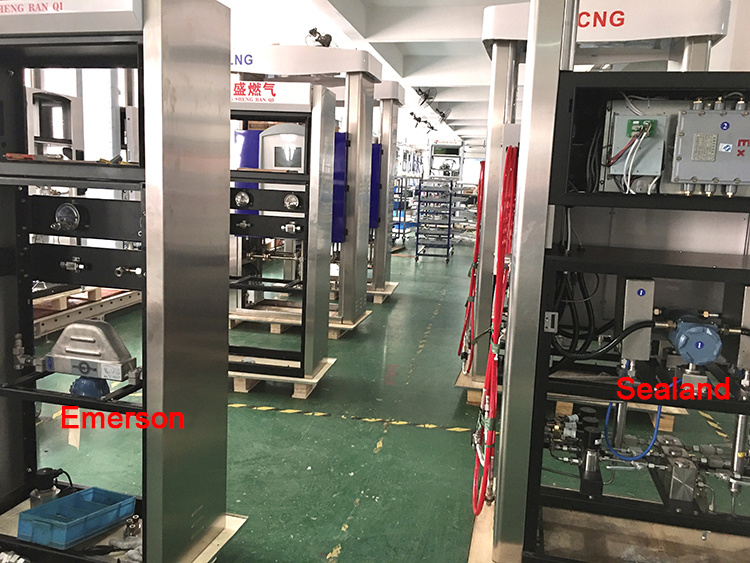
CNG Dispenser Mass Flow Meter, LNG Dispenser Mass Flow Meter, LPG Dispenser Mass Flow Meter
Zhejiang Sealand Technology Co., Ltd. , https://www.sealandflowmeters.com